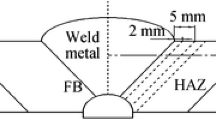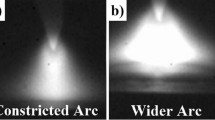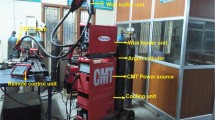Abstract
The effect of welding current and polarity, i.e. AC and DCEN, on imposed thermal cycles, mechanical properties, microstructural events and residual stresses was investigated in GTA welding of AA5052. A three-dimensional thermo-mechanical model was utilized to evaluate thermal responses and residual stresses distribution in the weldments. Tensile testing and hardness measurements were also conducted to study the effect of welding polarity on the mechanical properties of components. Microstructural observations utilizing optical microscopy were carried out to assess the microstructural evolutions. The results show that wide varieties of microstructures are produced in DCEN sample from cells at the fusion boundary to equiaxed dendrites at the centre line. However, in the sample welded by AC current, the produced microstructure changes from columnar dendritic at the fusion line to equiaxed dendritic at the centre line. Although, these microstructural changes have no significant effects on the mechanical properties of weld metal. Furthermore, wider temperature contours in the AC sample resulted in a wider heat affected zone, i.e. 9.5 vs. 6.4 mm, and larger tensile residual stresses are produced in the longitudinal direction in the sample welded under DCEN polarity.

















Similar content being viewed by others
References
Goldak JA, Akhlaghi M (2005) Computational welding mechanics. Springer, New York
Preston RV, Shercliff HR, Withers PJ, Smith SD (2003) Finite element modelling of tungsten inert gas welding of aluminium alloy 2024. Sci Technol Weld Join 8(1):10–18
Spina R, Tricarico L, Basile G, Sibillano T (2007) Thermo-mechanical modeling of laser welding of AA5083 sheets. J Mater Process Technol 191:215–219
Barroso A, Cañas J, Picón R, París F, Méndez C, Unanue I (2010) Prediction of welding residual stresses and displacements by simplified models. Experimental validation. Mater Des 31(3):1338–1349
Gilles P, El-Ahmar W, Jullien J-F (2009) Robustness analyses of numerical simulation of fusion welding NeT-TG1 application: “single weld-bead-on-plate”. Int J Press Vessel Pip 86(1):3–12
Zeng Z, Wang L, Du P, Li X (2010) Determination of welding stress and distortion in discontinuous welding by means of numerical simulation and comparison with experimental measurements. Comput Mater Sci 49(3):535–543
Bajpei T, Chelladurai H, Ansari MZ (2016) Mitigation of residual stresses and distortions in thin aluminium alloy GMAW plates using different heat sink models. J Manuf Process 22:199–210
Magalhães ES, Carvalho SR, de Lima e Silva ALF, Lima e Silva SMM (2015) The use of non-linear inverse problem and enthalpy method in GTAW process of aluminum. Int Commun Heat Mass Trans 66:114–121
Zain-ul-abdein M, Nélias D, Jullien J-F, Deloison D (2010) Experimental investigation and finite element simulation of laser beam welding induced residual stresses and distortions in thin sheets of AA 6056-T4. Mater Sci Eng A 527(12):3025–3039
Jeong H, Park K, Baek S, Cho J (2019) Thermal efficiency decision of variable polarity aluminum arc welding through molten pool analysis. Int J Heat Mass Transf 138:729–737
D-k Z, Zhao Y, Dong M-y, Wang G-q, Wu A-p, J-g S, D-y M, X-l L, J-l S, Z-p Z (2019) Effects of weld penetration on tensile properties of 2219 aluminum alloy TIG-welded joints. Trans Nonferrous Metals Soc China 29(6):1161–1168
Lewis SJ, Alizadeh H, Gill C, Vega A, Murakawa H, El-Ahmar W, Gilles P, Smith DJ, Truman CE (2009) Modelling and measurement of residual stresses in autogenously welded stainless steel plates: part 1—fabrication and modelling. Int J Press Vessel Pip 86(12):798–806
Danis Y, Lacoste E, Arvieu C (2010) Numerical modeling of Inconel 738LC deposition welding: prediction of residual stress induced cracking. J Mater Process Technol 210(14):2053–2061
Singh RP, Garg RK, Shukla DK (2016) Mathematical modeling of effect of polarity on weld bead geometry in submerged arc welding. J Manuf Process 21:14–22
Hernandez M, Ambriz RR, Cortes R, GoMora CM, Plascencia G, Jaramillo D (2019) Assessment of gas tungsten arc welding thermal cycles on Inconel 718 alloy. Trans Nonferrous Metals Soc China 29(3):579–587
Ranjbarnodeh E, Serajzadeh S, Kokabi AH, Hanke S, Fischer A (2011) Finite element modeling of the effect of heat input on residual stresses in dissimilar joints. Int J Adv Manuf Technol 55(5):649–656
Committee ASM (1990) ASM handbook, volume 02—properties and selection: nonferrous alloys and special-purpose materials, 10th edn. ASM International, Metals Park
Zhu XK, Chao YJ (2002) Effects of temperature-dependent material properties on welding simulation. Comput Struct 80(11):967–976
Kohandehghan AR, Serajzadeh S (2011) Arc welding induced residual stress in butt-joints of thin plates under constraints. J Manuf Process 13(2):96–103
De A, DebRoy T (2004) A smart model to estimate effective thermal conductivity and viscosity in the weld pool. J Appl Phys 95(9):5230–5240
Deng D (2009) FEM prediction of welding residual stress and distortion in carbon steel considering phase transformation effects. Mater Des 30(2):359–366
Goldak J, Chakravarti A, Bibby M (1984) A new finite element model for welding heat sources. Metall Trans B 15(2):299–305
Pavelic V, Tanbakuchi R, Uyehara OA, Myers PS (1969) Experimental and computed temperature histories in gas tungsten arc welding of thin plates. Weld J Res Suppl 48:295s–305s
Gourd LM (1995) Principle of welding technology, 3rd edn. Edward Arnold, London
Grong Ø (1994) Metallurgical modelling of welding. Institute of Materials, London
Kou S (2003) Welding metallurgy, 2nd edn. Wiley, Hoboken
Belytschko T, Liu WK, Moran B (2000) Nonlinear finite element methods for continua and structures. John Wiley and Sons, Chichester
Kang SH, Im YT (2007) Thermo-elasto-plastic finite element analysis of quenching process of carbon steel. J Mater Process Technol 192-193:381–390
Rokhlin SI, Guu AC (1993) A study of arc force, pool depression and weld penetration during gas tungsten arc welding
Farzadi A, Serajzadeh S, Kokabi AH (2010) Investigation of weld pool in aluminum alloys: geometry and solidification microstructure. Int J Therm Sci 49(5):809–819
Funding
This research did not receive any specific grant from funding agencies in the public, commercial, or not-for-profit sectors.
Author information
Authors and Affiliations
Corresponding author
Additional information
Publisher’s note
Springer Nature remains neutral with regard to jurisdictional claims in published maps and institutional affiliations.
Rights and permissions
About this article
Cite this article
Sarmast, A., Serajzadeh, S. The influence of welding polarity on mechanical properties, microstructure and residual stresses of gas tungsten arc welded AA5052. Int J Adv Manuf Technol 105, 3397–3409 (2019). https://doi.org/10.1007/s00170-019-04580-7
Received:
Accepted:
Published:
Issue Date:
DOI: https://doi.org/10.1007/s00170-019-04580-7




